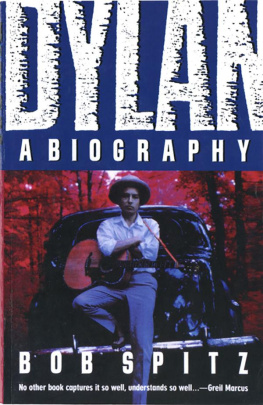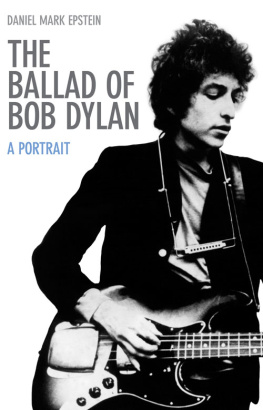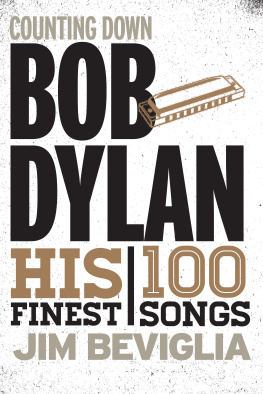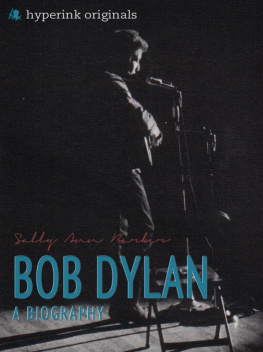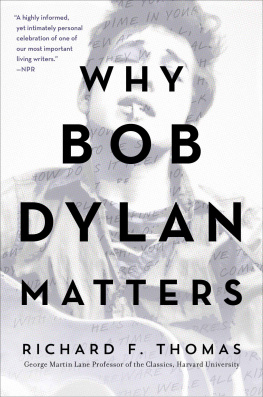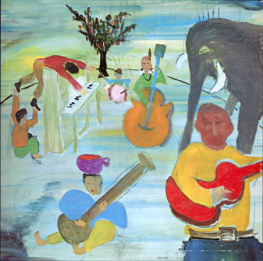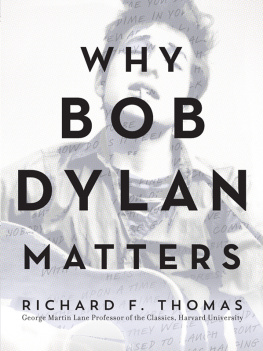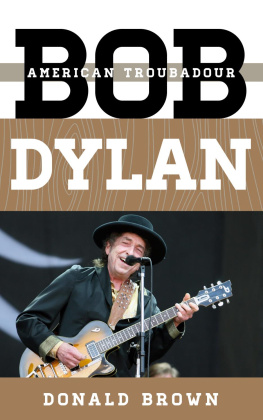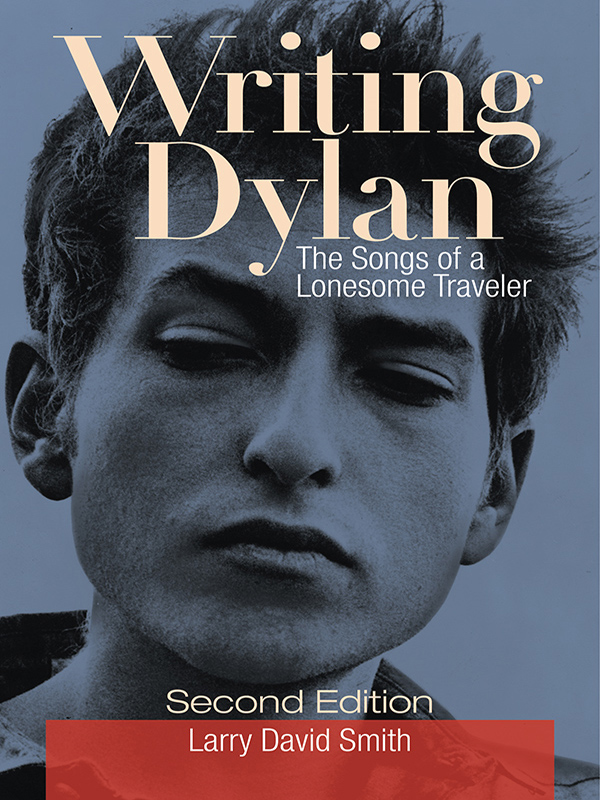Writing Dylan
Copyright 2019 by Larry David Smith
All rights reserved. No part of this publication may be reproduced, stored in a retrieval system, or transmitted, in any form or by any means, electronic, mechanical, photocopying, recording, or otherwise, except for the inclusion of brief quotations in a review, without prior permission in writing from the publisher.
Library of Congress Cataloging-in-Publication Data
Names: Smith, Larry David, author.
Title: Writing Dylan : the songs of a lonesome traveler / Larry David Smith.
Description: Second edition. | Santa Barbara, California : Praeger, [2019] | Includes bibliographical references and index.
Identifiers: LCCN 2018030054 (print) | LCCN 2018032371 (ebook) | ISBN 9781440861598 (eBook) | ISBN 9781440861581 (hardcopy : alk. paper)
Subjects: LCSH: Dylan, Bob, 1941Criticism and interpretation. | Popular musicUnited StatesHistory and criticism.
Classification: LCC ML420.D98 (ebook) | LCC ML420.D98 S56 2019 (print) | DDC 782.42164092dc23
LC record available at https://lccn.loc.gov/2018030054
ISBN: 978-1-4408-6158-1 (print)
978-1-4408-6159-8 (ebook)
23 22 21 20 19 1 2 3 4 5
This book is also available as an eBook.
Praeger
An Imprint of ABC-CLIO, LLC
ABC-CLIO, LLC
130 Cremona Drive, P.O. Box 1911
Santa Barbara, California 93116-1911
www.abc-clio.com
This book is printed on acid-free paper 
Manufactured in the United States of America
To Eric
Contents
Welcome to the second edition of Writing Dylan: The Songs of a Lonesome Traveler. Its been a long time since 2005. So many things have happened over the past 13 years: new songs, revealing interviews and commentaries, hundreds of performances, and a Nobel Prize to name but a few. The albums Modern Times, Together through Life, and Tempest join comprehensive boxed sets capturing the Basement Tapes, the 1966 Tour, studio outtakes from 1965 to 1966, the gospel years, and so much more to advance our knowledge of Bob Dylans historic career. Dylans speeches for the 2015 MusiCares Person of the Year award and in response to the 2016 Nobel Prize in Literature complement assorted interviews to deepen our understanding of this uniquely American artist. So much has transpired that a second edition is surely warranted.
But one thing hasnt changed. Just as I opened the first edition by praising Eric Levys invaluable contributions, I begin this effort with more of the same. This time, however, I cut to the chase and dedicate the work to Eric. Its simple, friends. This book would not be here without Eric Levy. Everybody needs a Book Whispererand I have mine. Thanks, Eric!
While this second edition sticks to the first installments argument that Bob Dylan orchestrated seven independent missions across his career, the presentation of that framework has changed, I hope, for the better. The original portrayal of the Dylan persona in terms of distinct components (e.g., Bobby Zimmerman, Bob Dillon, and Bob Dylan, etc.) has been removed. The idea remains but the expression is simplified for the sake of clarity. Much of the material pertaining to Dylans working method has been moved from the original closing chapter to its own section that is presented before the lifework. By having that information up front, I think youll be better prepared for the unfolding story. It also provides a template through which we may engage the songwriting. Not only has the book been updated with all of the post-2005 material, a new chapter has been added that specifically addresses Dylans concert tours from 1988 to 2018. The Show is such an integral part of Bobs art that it requires its own treatment. The laureates dogged determination to advance his career and to keep his songwriting alive is a courageous, inspiringand, ultimately, definingstory. Otherwise, Ive generally revised and extended my remarks throughout the volume. Enjoy!
As with the first edition, I do all of this with an emphasis on the art over all other considerations. Thanks to my colleagues at Bob Dylan Music, I have access to a Nobel Prize winning body of work. It was an honor before and its even more so now. As a result, Ive tried to stay in my lane. The biographers cover their ground. The musicologists tackle their interests. And the Dylanologists have lots to share. Its all good. But Im on a different journey. I use personal information only where warranted. I probe into the arts possible antecedents only as necessary. Instead, I offer a narrative interpretation of the lifework. And, as we all know, Bob Dylan is an accomplished storyteller. That he systematically deploys specific storytelling signatures in strategic ways is my personal gold mine. My job is to share that yield with you. It promises to be a mother lode.
That job has certainly benefited from a host of contributors, and I must thank everyone who helped along the way. That list begins with Jeff Rosen, David Beal, and everybody at Bob Dylan Music. Jeff Rosen made this work possible. His trust is so inspiring. He does a great job of marshalling Bob Dylans historic resources and representing his client. Dylans lifework is in capable hands, and everybody benefits from that professionalism. Thanks, Jeff!
I must also say that anything I do with music criticism owes a tremendous debt to Nicola Joss and Pete Townshend. Nicola kept this whole thing rolling, and Petes generosity brought it all home. Nic and Pete are world-class people. I love them dearly. Thanks again, Nicola and Pete!
Another thank-you goes out to Praeger and Catherine Lafuente for once again supporting the project. Catherines enthusiasm is so motivational. I hope this makes her proud. I also want to thank Suchitra Raghavalu and the fine folks at Amnet Systems for their assistance in preparing the manuscript. Great work everybody!
Special thanks go out to the Bob Crew: the adorable Donna Rizzo, Mark Bu Baitinger, Brent and Mary Tebeau, and two extraordinarily loyal people, Klaus and Claudia Ahl. I also want to thank Rob Fox and Dave Sloane for Rocky and their kind support. Special thanks go out to Sudesh Bob Kedar and the patient people of Plantation Pointe: Janice, Sneaky Jet, Elaine, Dr. Cookie, and Charlie. So many world-class people! Thank you all so very much. And, finally, I must repeat what I said in the first edition when I dedicated that volume to my professors at Ohio State: James L. Golden, Jack Douglas, William Brown, and Joe Foley. As they say, theyre responsible but not to blame. OH-IO.
Genius is a freakish force of nature. Its anything but subtle. It yells at you. When you sit in its aftermath, you feel the transformational power of ultimate achievement. Its an amazing experience. But genius does one thing above all others: it tells its own story. Lay out the work, step back, and shut up. The art speaks for itself, and I try to frame it in terms of the functional conditions that produced it. That too is self-evident. Its also a good story. Yep, genius is rarely subtle. It systematically screams.
This book is about genius. Look out, kid.
October 13, 2016, was a great day for American art. It was also a special moment in music history. For the first time since 1993, an American won the Nobel Prize in Literature. For the first time ever, a musician won this prestigious award. All of that culminated in the 2016 prizewinner: American musician Bob Dylan. That convergence contributed mightily to the awards significance. It was, indeed, a great day for American art.


